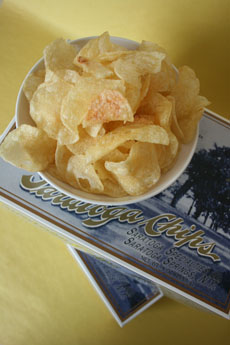

The original potato chips, Saratoga Chips, have been revived. Find them at The Nibble Gourmet Market. Photo by Hannah Kaminsky | THE NIBBLE.
|
KAREN HOCHMAN is Editorial Director of THE NIBBLE.
|
|
May 2005
Last Updated March 2012
|
 |
Potato Chip Origin
Page 3: The Potato Chip Evolves
This is Page 3 of a five-page article on the origin of the potato chip. Click on the black links below to view the other pages.
The Potato Chip Evolves
For several decades after their creation in upstate New York, through the early part of the twentieth century, Saratoga Chips were largely a side dish served in the Northeast, at restaurants and special occasion dinners.
William Tappendon of Cleveland is credited with being the first to sell potato chips to grocery stores, in 1895. He began making chips in his kitchen and then turned his barn into the world’s first potato chip factory.
The First Potato Chip Factories
- The early 1900s saw the development of several large factories for the mass production of potato chips. Companies large and small sprang up all over the country: Leonminster Potato Chip Co.* (later Tri-Sum) in Leonminster, Massachusetts (1908); Mikesell’s Potato Chips* in Dayton, Ohio (1910); George Dentzler in Houston, Texas (1910); Dan Dee Pretzel and Potato Chip Company* in Cleveland, Ohio (1913). Through the 1920s, new chip factories included Num Num in Cleveland, Ohio (1918); Blue Bell in Illinois (1919); Wise Delicatessen Company* in Berwick, Pennsylvania (1921); Hanover Home Brand Potato Chips (later Utz*) in Hanover, Pennsylvania (1921); Magic Food Co. (later Golden Flake*) in Birmingham, Alabama (1921); Moore’s* in Bristol, Virginia (1924); and Scudder’s* in Monterey Park, California (1926). Even today, with two huge national brands (Lay’s and Wise), consumers remain very loyal to their regional brands.
- In 1921, potato chips were introduced to England; but because the Brits already used the word “chips” for what we call french fries (i.e., fish and chips), they chose the word “crisps” instead.
*Still in business today, some under a different name or ownership.
The Invention Of The Potato Chip Bag
Why the burst of growth in the 1920s? Aside from the popularity of the chips themselves, it was low-level technology. Previously, potatoes had to be tediously peeled and sliced by hand.
- Invention Of The Potato Peeler. In the early 1920s, the mechanical potato peeler was invented—the same type of gadget most of us use to peel potatoes today. This paved the way for potato chips to grow from a small specialty item to a top-selling snack food.
- Invention Of The Sealed, Moisture-Resistant Bag. According to the Snack Food Association, potato chips did not become a mainstream snack food until the invention of the sealed bag. Prior to then, potato chips were stored in glass display cases or in barrels; the chips at the bottom of the barrel were often stale and damp. In 1926, the next big step forward occurred. Laura Scudder, the California chip manufacturer, invented the moisture-resistant potato chip bag by ironing together two pieces of wax paper. Every evening, her women employees took home sheets of wax paper and ironed them into bags. The next day, workers would pack chips into the bags, seal the tops with warm irons and deliver them to retailers. This created a seal and kept the chips fresh until opened. Her product, Scuds (in the days before missiles, it was a play on spuds and her surname), was the first to be sold in airtight sacks.
- Invention Of The Glassine Bag. Around the same time, cellophane began to appear, and a few years later, glassine. In 1933, the first pre-print waxed glassine bag debuted and provided a place for brand identification and advertising. Bagged chips meant self-service: no clerk was required to measure and weigh the chips.
- Invention Of The Continuous Fryer. Potato chips were fried in small kettles (today’s gourmet “kettle chips” are a return to the thicker, small batch-style made with better ingredients, i.e., before mass production took over). The continuous fryer was invented in 1929, creating tremendous economies of scale and driving most of the small kettle-cookers out of business.
- Establishment Of The H.W. Lay Distributing Company. In 1932, 24-year-old Herman W. Lay began as a route salesman for the Barrett Food Products Company, an Atlanta manufacturer of Gardner’s Potato Chips. Two years later he founded the H.W. Lay Distributing Company, distributing for the Barrett Food Products Company; three years later he had 25 employees and had begun producing his own line of snack foods, building a business and a brand that would become synonymous with America’s favorite salty snack. By 1937, Lay’s potato chips had become the first successfully marketed national brand of chips. In September 1961, H.W. Lay & Company merged with The Frito Company, creating the largest-selling snack food company in the United States, Frito-Lay, Inc. (In June 1965, Frito-Lay and Pepsi-Cola merged to become PepsiCo.)
|
|

Herman W. Lay
at the top of his
game. |
Continue To Page 4: The First Salted & Flavored Potato Chips
Go To The Article Index Above
Lifestyle Direct, Inc. All rights reserved. Images are the copyright of their respective owners.

|





